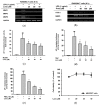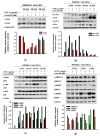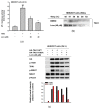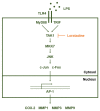Anti-Inflammatory Activities of an Anti-Histamine Drug, Loratadine, by Suppressing TAK1 in AP-1 Pathway
- PMID: 35409346
- PMCID: PMC8999734
- DOI: 10.3390/ijms23073986
Anti-Inflammatory Activities of an Anti-Histamine Drug, Loratadine, by Suppressing TAK1 in AP-1 Pathway
Abstract
Loratadine is an anti-histamine routinely used for treating allergies. However, recent findings have shown that Loratadine may also have anti-inflammatory functions, while their exact mechanisms have not yet been fully uncovered. In this paper, we investigated whether Loratadine can be utilized as an anti-inflammatory drug through a series of in vitro and in vivo experiments using a murine macrophage cell line and an acute gastritis mouse model. Loratadine was found to dramatically reduce the expression of pro-inflammatory genes, including MMP1, MMP3, and MMP9, and inhibit AP-1 transcriptional activation, as demonstrated by the luciferase assay. Therefore, we decided to further explore its role in the AP-1 signaling pathway. The expression of c-Jun and c-Fos, AP-1 subunits, was repressed by Loratadine and, correspondingly, the expression of p-JNK, p-MKK7, and p-TAK1 was also inhibited. In addition, Loratadine was able to reduce gastric bleeding in acute gastritis-induced mice; Western blotting using the stomach samples showed reduced p-c-Fos protein levels. Loratadine was shown to effectively suppress inflammation by specifically targeting TAK1 and suppressing consequent AP-1 signaling pathway activation and inflammatory cytokine production.
Keywords: AP-1; Loratadine; TAK1; anti-inflammatory effect.
Conflict of interest statement
The authors have no conflicts of interest to declare.
Figures





Similar articles
-
Loratadine, an antihistamine drug, exhibits anti-inflammatory activity through suppression of the NF-kB pathway.Biochem Pharmacol. 2020 Jul;177:113949. doi: 10.1016/j.bcp.2020.113949. Epub 2020 Apr 3. Biochem Pharmacol. 2020. PMID: 32251678
-
Euodia pasteuriana Methanol Extract Exerts Anti-Inflammatory Effects by Targeting TAK1 in the AP-1 Signaling Pathway.Molecules. 2020 Dec 7;25(23):5760. doi: 10.3390/molecules25235760. Molecules. 2020. PMID: 33297427 Free PMC article.
-
TAK1 in the AP-1 pathway is a critical target of Saururus chinensis (Lour.) Baill in its anti-inflammatory action.J Ethnopharmacol. 2021 Oct 28;279:114400. doi: 10.1016/j.jep.2021.114400. Epub 2021 Jul 7. J Ethnopharmacol. 2021. PMID: 34245837
-
TAK1/AP-1-Targeted Anti-Inflammatory Effects of Barringtonia augusta Methanol Extract.Molecules. 2021 May 20;26(10):3053. doi: 10.3390/molecules26103053. Molecules. 2021. PMID: 34065429 Free PMC article.
-
Cissus subtetragona Planch. Ameliorates Inflammatory Responses in LPS-induced Macrophages, HCl/EtOH-induced Gastritis, and LPS-induced Lung Injury via Attenuation of Src and TAK1.Molecules. 2021 Oct 8;26(19):6073. doi: 10.3390/molecules26196073. Molecules. 2021. PMID: 34641616 Free PMC article.
Cited by
-
Antioxidant, Anti-Inflammatory, Anti-Menopausal, and Anti-Cancer Effects of Lignans and Their Metabolites.Int J Mol Sci. 2022 Dec 7;23(24):15482. doi: 10.3390/ijms232415482. Int J Mol Sci. 2022. PMID: 36555124 Free PMC article. Review.
-
Amelioration of acetic acid-induced ulcerative colitis in rats by cetirizine and loratadine via regulation of the PI3K/Akt/Nrf2 signalling pathway and pro-inflammatory cytokine release.Iran J Basic Med Sci. 2024;27(6):761-767. doi: 10.22038/IJBMS.2024.75889.16426. Iran J Basic Med Sci. 2024. PMID: 38645494 Free PMC article.
-
Evaluation of the Effect of Loratadine versus Diosmin/Hesperidin Combination on Vinca Alkaloids-Induced Neuropathy: A Randomized Controlled Clinical Trial.Pharmaceuticals (Basel). 2024 May 9;17(5):609. doi: 10.3390/ph17050609. Pharmaceuticals (Basel). 2024. PMID: 38794179 Free PMC article.
-
Role of Marine Bacterial Contaminants in Histamine Formation in Seafood Products: A Review.Microorganisms. 2022 Jun 11;10(6):1197. doi: 10.3390/microorganisms10061197. Microorganisms. 2022. PMID: 35744715 Free PMC article. Review.
-
Advances in clinical application of H1 antihistamines in the treatment of skin diseases.Zhong Nan Da Xue Xue Bao Yi Xue Ban. 2024 Feb 28;49(2):182-189. doi: 10.11817/j.issn.1672-7347.2024.230452. Zhong Nan Da Xue Xue Bao Yi Xue Ban. 2024. PMID: 38755714 Free PMC article. Review. Chinese, English.
References
MeSH terms
Substances
Grants and funding
LinkOut - more resources
Full Text Sources
Medical
Research Materials
Miscellaneous

